![[BSS]_Hoshi_o_Ou_Kodomo_[1080p][9B65AF05].mkv_snapshot_00.02.11_[2011.12.07_20.12.39] [BSS]_Hoshi_o_Ou_Kodomo_[1080p][9B65AF05].mkv_snapshot_00.02.11_[2011.12.07_20.12.39]](https://lh3.ggpht.com/-jtaYbNwDWIU/TuBxHY_BxXI/AAAAAAAAisg/IItVApo8lgo/%25255BBSS%25255D_Hoshi_o_Ou_Kodomo_%25255B1080p%25255D%25255B9B65AF05%25255D.mkv_snapshot_00.02.11_%25255B2011.12.07_20.12.39%25255D_thumb.jpg?imgmax=800) |
![[BSS]_Hoshi_o_Ou_Kodomo_[1080p][9B65AF05].mkv_snapshot_00.19.37_[2011.12.07_20.31.22] [BSS]_Hoshi_o_Ou_Kodomo_[1080p][9B65AF05].mkv_snapshot_00.19.37_[2011.12.07_20.31.22]](https://lh5.ggpht.com/-DC3cJsaq3pM/TuBxJfQnnAI/AAAAAAAAisw/BbOOW9WR8cQ/%25255BBSS%25255D_Hoshi_o_Ou_Kodomo_%25255B1080p%25255D%25255B9B65AF05%25255D.mkv_snapshot_00.19.37_%25255B2011.12.07_20.31.22%25255D_thumb.jpg?imgmax=800) |
![[BSS]_Hoshi_o_Ou_Kodomo_[1080p][9B65AF05].mkv_snapshot_01.00.09_[2011.12.07_21.17.24] [BSS]_Hoshi_o_Ou_Kodomo_[1080p][9B65AF05].mkv_snapshot_01.00.09_[2011.12.07_21.17.24]](https://lh5.ggpht.com/-ooTHFBUJgBk/TuBxLZ1XwwI/AAAAAAAAitA/yiCkDm7NxFE/%25255BBSS%25255D_Hoshi_o_Ou_Kodomo_%25255B1080p%25255D%25255B9B65AF05%25255D.mkv_snapshot_01.00.09_%25255B2011.12.07_21.17.24%25255D_thumb.jpg?imgmax=800) |
“Children Who Chase Lost Voices from Deep Below”
I honestly don’t think it’s an exaggeration to say that Shinkai Makoto is the most important anime director in the world. But while I’ve been arguing for years that the endless examples of him being called “The Next Miyazaki” were off base, it appears as if Shinkai-sensei may have taken them to heart.
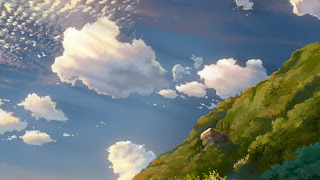 Let me back up and say that I consider “The Next Miyazaki” to be a compliment of the highest order. Miyazaki Hayao is the most commercially successful anime director – and the only one to have truly broken through in Western popular culture – for a reason. He’s created a string of wonderful films that have a signature look to them, as well as a unique ability to appeal to children and adults. He’s a master storyteller, an artist at combining simplicity and profundity, and an auteur of the highest order. So it’s not a matter of “defending” Shinkai from the charge – it’s simply that up to now, I don’t think it’s been very accurate. I think the mantle would have fit much more naturally on the shoulders of Hosoda Mamoru (Summer Wars, The Girl Who Leapt Through Time). Like the master himself, Hosoda’s films have a slickness to the storytelling and an undercurrent of wistful humor. Both men, for me, are masters of prose in animation form.
Let me back up and say that I consider “The Next Miyazaki” to be a compliment of the highest order. Miyazaki Hayao is the most commercially successful anime director – and the only one to have truly broken through in Western popular culture – for a reason. He’s created a string of wonderful films that have a signature look to them, as well as a unique ability to appeal to children and adults. He’s a master storyteller, an artist at combining simplicity and profundity, and an auteur of the highest order. So it’s not a matter of “defending” Shinkai from the charge – it’s simply that up to now, I don’t think it’s been very accurate. I think the mantle would have fit much more naturally on the shoulders of Hosoda Mamoru (Summer Wars, The Girl Who Leapt Through Time). Like the master himself, Hosoda’s films have a slickness to the storytelling and an undercurrent of wistful humor. Both men, for me, are masters of prose in animation form.
 So what of “the most important director”, Shinkai? If those men are geniuses at spinning tales, Shinkai is a visual poet. His works are stranger and more distant, sometimes awkward in the narrative construction and resolutely earnest rather than gently playful. But above all, they’re beautiful. With a far leaner spine of story, Shinkai is able to transport the audience by the sheer beauty of his art, the way a poet does – every Shinkai movie, in its way, feels as if it’s a window into his soul. His stories haven’t always measured up to his visuals, but in the sublime Byōsoku 5 Centimeter I believe Shinkai achieved transcendence. For me, the first of the three stories that comprise the film, “Cherry Blossoms”, is the most perfect 25 minutes of animation ever created. In the simple and heartbreaking story of a pure love between two 13 year-olds separated by fate and their journey towards one last meeting, Shinkai found a narrative that suited his muse perfectly. For all the agonizing detail of his art, his stories are at their best when exploring simple themes of loss and longing. The rest of that movie isn’t at the same level narratively (though it’s still superb) but that first chapter stands alone as a perfect marriage of story, art and a gorgeous soundtrack by piano composer Tenmon.
So what of “the most important director”, Shinkai? If those men are geniuses at spinning tales, Shinkai is a visual poet. His works are stranger and more distant, sometimes awkward in the narrative construction and resolutely earnest rather than gently playful. But above all, they’re beautiful. With a far leaner spine of story, Shinkai is able to transport the audience by the sheer beauty of his art, the way a poet does – every Shinkai movie, in its way, feels as if it’s a window into his soul. His stories haven’t always measured up to his visuals, but in the sublime Byōsoku 5 Centimeter I believe Shinkai achieved transcendence. For me, the first of the three stories that comprise the film, “Cherry Blossoms”, is the most perfect 25 minutes of animation ever created. In the simple and heartbreaking story of a pure love between two 13 year-olds separated by fate and their journey towards one last meeting, Shinkai found a narrative that suited his muse perfectly. For all the agonizing detail of his art, his stories are at their best when exploring simple themes of loss and longing. The rest of that movie isn’t at the same level narratively (though it’s still superb) but that first chapter stands alone as a perfect marriage of story, art and a gorgeous soundtrack by piano composer Tenmon.
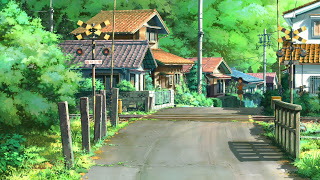 So when I say Hoshi Ou Kodomo is Shinkai’s most prosaic work, I don’t mean it in a positive sense. There’s no question that the director has come a long way from the days where he produced entire films on his Mac. While some standard Shinkai themes are explored here, the presentation is far more orthodox and polished than in any of his earlier films. The character designs are eerily reminiscent of Ghibli – as is the animation if you don’t look too closely – and the story is far more linear and straightforward than in any Shinkai film to date. Mind you, this is very good prose for the most part, but it’s still prose and I can’t help but feel that fewer words serve Shinkai better. There’s too much of everything here – too much story, too many characters, too much structure. Some of the grace and spare elegance of his best work is missing. Yet, in the end, it’s still a transformative experience and I think there are a couple of reasons for that.
So when I say Hoshi Ou Kodomo is Shinkai’s most prosaic work, I don’t mean it in a positive sense. There’s no question that the director has come a long way from the days where he produced entire films on his Mac. While some standard Shinkai themes are explored here, the presentation is far more orthodox and polished than in any of his earlier films. The character designs are eerily reminiscent of Ghibli – as is the animation if you don’t look too closely – and the story is far more linear and straightforward than in any Shinkai film to date. Mind you, this is very good prose for the most part, but it’s still prose and I can’t help but feel that fewer words serve Shinkai better. There’s too much of everything here – too much story, too many characters, too much structure. Some of the grace and spare elegance of his best work is missing. Yet, in the end, it’s still a transformative experience and I think there are a couple of reasons for that.
 First, and foremost, Shinkai-sensei has lost none of this visual magic. Simply put, the man is an artist of the highest caliber – no one living or dead can do as much with color or light in the animation medium. I’ve said it before, but Shinkai’s art isn’t photo-realistic – it’s beyond realism. The man is somehow able to capture the essence of what we see in the real world and present it in a way that speaks to the heart, as if we’re seeing a Platonic ideal of a sunrise or a cloud-dappled sky with a bird soaring, or a train crossing a snowy landscape with a lone mountain behind it. To call Shinkai’s backgrounds beautiful simply doesn’t do them justice – no animator before or since has been able to move me to tears merely by the gift of his art, but Shinkai can. And Hoshi Ou Kodomo is an incredibly beautiful film, start to finish. Not even Ghibli can match Shinkai in this area – visually, this is all I could ever hope for, and more. There are times, frankly, when the urge simply to stop and gape takes away from the story itself, and this has been an occasional problem for Shinkai as his stories aren’t always cogent and compelling. And sadly, there are times during this film when that’s the case.
First, and foremost, Shinkai-sensei has lost none of this visual magic. Simply put, the man is an artist of the highest caliber – no one living or dead can do as much with color or light in the animation medium. I’ve said it before, but Shinkai’s art isn’t photo-realistic – it’s beyond realism. The man is somehow able to capture the essence of what we see in the real world and present it in a way that speaks to the heart, as if we’re seeing a Platonic ideal of a sunrise or a cloud-dappled sky with a bird soaring, or a train crossing a snowy landscape with a lone mountain behind it. To call Shinkai’s backgrounds beautiful simply doesn’t do them justice – no animator before or since has been able to move me to tears merely by the gift of his art, but Shinkai can. And Hoshi Ou Kodomo is an incredibly beautiful film, start to finish. Not even Ghibli can match Shinkai in this area – visually, this is all I could ever hope for, and more. There are times, frankly, when the urge simply to stop and gape takes away from the story itself, and this has been an occasional problem for Shinkai as his stories aren’t always cogent and compelling. And sadly, there are times during this film when that’s the case.
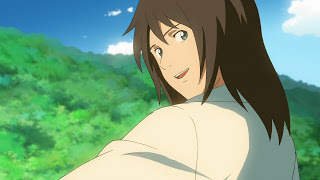 The other reason I believe “Children Who Chase Lost Voices” ultimately succeeds as a whole (though not to the extent “5 CM” does) is that Shinkai’s poet’s soul can still communicate simple and pure emotions as well as anyone in anime, even with all the makeup and pretty clothes they’re wearing here. For all it’s big-boy pants and polish, this is still a Shinkai film at heart and that means it’s about things all of us understand – the pain of losing someone we love and the desire to be with the one we love for all eternity. Shinkai – who left behind his sci-fi trappings for the gritty realism of Byōsoku 5 Centimeter – here embraces full-on fantasy for the first time in his career. The setting is somewhere in rural Japan, seemingly sometime in the recent past. A young girl, Asuna (Kanemoto Hisako, Ika from Shinryaku Ika Musume) lives alone with her mother, who’s busy with her nursing career and rarely home. Her father has passed, and the girl spends much of her time wandering the gorgeously rendered mountain landscape accompanied only by an odd little orange and white cat she’s called Mimi (Takeuchi Junko).
The other reason I believe “Children Who Chase Lost Voices” ultimately succeeds as a whole (though not to the extent “5 CM” does) is that Shinkai’s poet’s soul can still communicate simple and pure emotions as well as anyone in anime, even with all the makeup and pretty clothes they’re wearing here. For all it’s big-boy pants and polish, this is still a Shinkai film at heart and that means it’s about things all of us understand – the pain of losing someone we love and the desire to be with the one we love for all eternity. Shinkai – who left behind his sci-fi trappings for the gritty realism of Byōsoku 5 Centimeter – here embraces full-on fantasy for the first time in his career. The setting is somewhere in rural Japan, seemingly sometime in the recent past. A young girl, Asuna (Kanemoto Hisako, Ika from Shinryaku Ika Musume) lives alone with her mother, who’s busy with her nursing career and rarely home. Her father has passed, and the girl spends much of her time wandering the gorgeously rendered mountain landscape accompanied only by an odd little orange and white cat she’s called Mimi (Takeuchi Junko).
 It’s one one of these trips that she’s confronted by what appears to be some sort of dinosaur on a railroad bridge outside of town. She’s saved from the creature by an oddly-dressed teenaged boy named Shun (Miyu Irino). He speaks of being from a foreign country called Agartha, a name Asuna hears later in class from her new teacher Morisaki-sensei (Inoue Kazuhiko, Nyanko-sensei from Natsume Yuujinchou) in a lecture about underworld myths from many cultures. It’s at this point that the story begins to get very complicated, as the crystal Asuna uses in her homemade radio kit reveals itself to be a “Clavis”, a fragment of the same crystal that Shun carries, and a key to opening the gates of the underworld. Some very Spielberg-like elements are introduced here, with a paramilitary organization interested in obtaining the key and a chase sequence through the hills and caves in the company of a boy who reveals himself to be Shun’s brother Shin (also voiced by Irino Miyu). The story eventually leads to the underworld of Agartha itself, a place which Morisaki-sensei has a profound interest in.
It’s one one of these trips that she’s confronted by what appears to be some sort of dinosaur on a railroad bridge outside of town. She’s saved from the creature by an oddly-dressed teenaged boy named Shun (Miyu Irino). He speaks of being from a foreign country called Agartha, a name Asuna hears later in class from her new teacher Morisaki-sensei (Inoue Kazuhiko, Nyanko-sensei from Natsume Yuujinchou) in a lecture about underworld myths from many cultures. It’s at this point that the story begins to get very complicated, as the crystal Asuna uses in her homemade radio kit reveals itself to be a “Clavis”, a fragment of the same crystal that Shun carries, and a key to opening the gates of the underworld. Some very Spielberg-like elements are introduced here, with a paramilitary organization interested in obtaining the key and a chase sequence through the hills and caves in the company of a boy who reveals himself to be Shun’s brother Shin (also voiced by Irino Miyu). The story eventually leads to the underworld of Agartha itself, a place which Morisaki-sensei has a profound interest in.
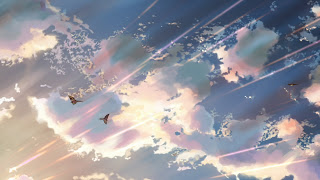 Much of the second half of the film takes place in this underground world of Agartha on a journey to the Gate of Life and Death, and it contains some of the most beautiful animation and backgrounds you’ll see, even in a Shinkai film. There are some beautiful ideas as well, such as the Quetzalcoatl, the ancient Gods who retreated to the underworld thousands of years ago in the company of a small group of mortals when the humans on the surface no longer needed them. Taking the forms of extinct species and Shinto Kami, they’re a sad and potent reminder of all that has been lost. There’s a larger story too, of surface dwellers who’ve come to Agartha in the past and decimated the land, and a redemptive journey for Shin, a lost boy trying to find his place in a dying world that’s rejected him. There’s real power, too in Morisaki’s tale of an undying love for his dead wife and his inability to move on without her. But ultimately, it’s all too big. I think Shinkai is trying to keep too many plates spinning here, and it doesn’t suit his writing style as well as a simpler story would. The larger narrative of Agartha plays like second-tier Ghibli, and the ending comes and goes much too quickly. The balance of the film is off in the sense that 110 minutes is spent building to its climactic moment, and the movie is over in less than five minutes afterwards. Considering the complexity of the story and the slow-paced buildup, the postscript should have been much longer. Again – for Shinkai, I really believe simpler is better.
Much of the second half of the film takes place in this underground world of Agartha on a journey to the Gate of Life and Death, and it contains some of the most beautiful animation and backgrounds you’ll see, even in a Shinkai film. There are some beautiful ideas as well, such as the Quetzalcoatl, the ancient Gods who retreated to the underworld thousands of years ago in the company of a small group of mortals when the humans on the surface no longer needed them. Taking the forms of extinct species and Shinto Kami, they’re a sad and potent reminder of all that has been lost. There’s a larger story too, of surface dwellers who’ve come to Agartha in the past and decimated the land, and a redemptive journey for Shin, a lost boy trying to find his place in a dying world that’s rejected him. There’s real power, too in Morisaki’s tale of an undying love for his dead wife and his inability to move on without her. But ultimately, it’s all too big. I think Shinkai is trying to keep too many plates spinning here, and it doesn’t suit his writing style as well as a simpler story would. The larger narrative of Agartha plays like second-tier Ghibli, and the ending comes and goes much too quickly. The balance of the film is off in the sense that 110 minutes is spent building to its climactic moment, and the movie is over in less than five minutes afterwards. Considering the complexity of the story and the slow-paced buildup, the postscript should have been much longer. Again – for Shinkai, I really believe simpler is better.
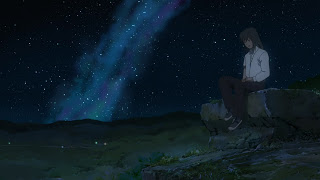 And yet, ultimately, there’s real power in that ending and real empathy for the characters. Some of it is of course Shinkai’s ability to touch the soul by way of the eye, which is unequalled and has never been greater. But even under all the unneeded padding the story itself still boils down to three lost souls – all of whom are lonely and grieving for a part of themselves that’s lost forever. The lost and the lonely are always given a compelling voice by Shinkai, who seems to understand them on a very fundamental level. It helps that the cast – Inoue-san is a particular standout – is uniformly excellent, though it does seem odd to hear familiar voices in a Shinkai film, even if they are superb actors all. Tenmon again provides the score, and again it’s lovely. It’s much more subdued here than in Byōsoku 5 Centimeter, which some may find an improvement. I found his earlier score to be the more powerful, however, and rather than being intrusive it almost became a character in the movie itself.
And yet, ultimately, there’s real power in that ending and real empathy for the characters. Some of it is of course Shinkai’s ability to touch the soul by way of the eye, which is unequalled and has never been greater. But even under all the unneeded padding the story itself still boils down to three lost souls – all of whom are lonely and grieving for a part of themselves that’s lost forever. The lost and the lonely are always given a compelling voice by Shinkai, who seems to understand them on a very fundamental level. It helps that the cast – Inoue-san is a particular standout – is uniformly excellent, though it does seem odd to hear familiar voices in a Shinkai film, even if they are superb actors all. Tenmon again provides the score, and again it’s lovely. It’s much more subdued here than in Byōsoku 5 Centimeter, which some may find an improvement. I found his earlier score to be the more powerful, however, and rather than being intrusive it almost became a character in the movie itself.
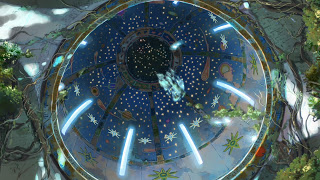 Ultimately, I think anyone who considers themselves a serious fan of anime needs to see every Shinkai film, and I cannot imagine anyone not being able to enjoy this one for the art and animation at the very least. How successfully the film works as a story will vary quite a bit depending on the viewer, I suspect, though for me the bittersweet pain that’s inherent in Shinkai’s narrative voice comes through clearly in spite of some missteps here. Shinkai is still a young man both chronologically and artistically – he’s only 38 years old and this is only the fifth time he’s directed what can truly be called a feature. There’s a part of me that worries that Shinkai’s writing may not age as well as his art. There’s a heartbreaking innocence to his worldview, a poet’s idealism that may or may not transition into something just as compelling as impending middle-age either mellows or deepens it. But whatever happens I eagerly await the next Shinkai work as I do with no other director, because he’s capable of soaring genius and inspiration that no one else in anime has proved the equal of. He’s a truly unique and singular talent, and I count myself lucky to be an anime fan while he’s at the peak of his creative powers.
Ultimately, I think anyone who considers themselves a serious fan of anime needs to see every Shinkai film, and I cannot imagine anyone not being able to enjoy this one for the art and animation at the very least. How successfully the film works as a story will vary quite a bit depending on the viewer, I suspect, though for me the bittersweet pain that’s inherent in Shinkai’s narrative voice comes through clearly in spite of some missteps here. Shinkai is still a young man both chronologically and artistically – he’s only 38 years old and this is only the fifth time he’s directed what can truly be called a feature. There’s a part of me that worries that Shinkai’s writing may not age as well as his art. There’s a heartbreaking innocence to his worldview, a poet’s idealism that may or may not transition into something just as compelling as impending middle-age either mellows or deepens it. But whatever happens I eagerly await the next Shinkai work as I do with no other director, because he’s capable of soaring genius and inspiration that no one else in anime has proved the equal of. He’s a truly unique and singular talent, and I count myself lucky to be an anime fan while he’s at the peak of his creative powers.
![[BSS]_Hoshi_o_Ou_Kodomo_[1080p][9B65AF05].mkv_snapshot_00.47.33_[2011.12.07_21.03.59] [BSS]_Hoshi_o_Ou_Kodomo_[1080p][9B65AF05].mkv_snapshot_00.47.33_[2011.12.07_21.03.59]](https://lh3.ggpht.com/-p0MTzoEot4Q/TuBxNT1RWZI/AAAAAAAAitQ/BSLtiJWP5es/%25255BBSS%25255D_Hoshi_o_Ou_Kodomo_%25255B1080p%25255D%25255B9B65AF05%25255D.mkv_snapshot_00.47.33_%25255B2011.12.07_21.03.59%25255D_thumb.jpg?imgmax=800) |
![[BSS]_Hoshi_o_Ou_Kodomo_[1080p][9B65AF05].mkv_snapshot_00.49.06_[2011.12.07_21.05.32] [BSS]_Hoshi_o_Ou_Kodomo_[1080p][9B65AF05].mkv_snapshot_00.49.06_[2011.12.07_21.05.32]](https://lh3.ggpht.com/-r3aK0c2ESrw/TuBxPJYC2xI/AAAAAAAAitg/TMMKE_R9dA4/%25255BBSS%25255D_Hoshi_o_Ou_Kodomo_%25255B1080p%25255D%25255B9B65AF05%25255D.mkv_snapshot_00.49.06_%25255B2011.12.07_21.05.32%25255D_thumb.jpg?imgmax=800) |
![[BSS]_Hoshi_o_Ou_Kodomo_[1080p][9B65AF05].mkv_snapshot_00.52.44_[2011.12.07_21.09.10] [BSS]_Hoshi_o_Ou_Kodomo_[1080p][9B65AF05].mkv_snapshot_00.52.44_[2011.12.07_21.09.10]](https://lh6.ggpht.com/-WNbwRiCO4xk/TuBxQe14ZzI/AAAAAAAAitw/-cPgyBJ5uHs/%25255BBSS%25255D_Hoshi_o_Ou_Kodomo_%25255B1080p%25255D%25255B9B65AF05%25255D.mkv_snapshot_00.52.44_%25255B2011.12.07_21.09.10%25255D_thumb.jpg?imgmax=800) |
![[BSS]_Hoshi_o_Ou_Kodomo_[1080p][9B65AF05].mkv_snapshot_00.53.19_[2011.12.07_21.09.45] [BSS]_Hoshi_o_Ou_Kodomo_[1080p][9B65AF05].mkv_snapshot_00.53.19_[2011.12.07_21.09.45]](https://lh4.ggpht.com/-T1AeKINcLFs/TuBxSO2nYiI/AAAAAAAAiuA/IhljY1KP6Ww/%25255BBSS%25255D_Hoshi_o_Ou_Kodomo_%25255B1080p%25255D%25255B9B65AF05%25255D.mkv_snapshot_00.53.19_%25255B2011.12.07_21.09.45%25255D_thumb.jpg?imgmax=800) |
![[BSS]_Hoshi_o_Ou_Kodomo_[1080p][9B65AF05].mkv_snapshot_00.53.43_[2011.12.07_21.10.57] [BSS]_Hoshi_o_Ou_Kodomo_[1080p][9B65AF05].mkv_snapshot_00.53.43_[2011.12.07_21.10.57]](https://lh4.ggpht.com/-qgNGuOqiLz0/TuBxThuBw_I/AAAAAAAAiuQ/PfgA2_rKPKk/%25255BBSS%25255D_Hoshi_o_Ou_Kodomo_%25255B1080p%25255D%25255B9B65AF05%25255D.mkv_snapshot_00.53.43_%25255B2011.12.07_21.10.57%25255D_thumb.jpg?imgmax=800) |
![[BSS]_Hoshi_o_Ou_Kodomo_[1080p][9B65AF05].mkv_snapshot_00.55.08_[2011.12.07_21.12.22] [BSS]_Hoshi_o_Ou_Kodomo_[1080p][9B65AF05].mkv_snapshot_00.55.08_[2011.12.07_21.12.22]](https://lh3.ggpht.com/-Yk8Of7ax9xU/TuBxVpcwoSI/AAAAAAAAiug/IdePM5riKOQ/%25255BBSS%25255D_Hoshi_o_Ou_Kodomo_%25255B1080p%25255D%25255B9B65AF05%25255D.mkv_snapshot_00.55.08_%25255B2011.12.07_21.12.22%25255D_thumb.jpg?imgmax=800) |
![[BSS]_Hoshi_o_Ou_Kodomo_[1080p][9B65AF05].mkv_snapshot_00.58.02_[2011.12.07_21.15.16] [BSS]_Hoshi_o_Ou_Kodomo_[1080p][9B65AF05].mkv_snapshot_00.58.02_[2011.12.07_21.15.16]](https://lh6.ggpht.com/-5lmwpk7f9r0/TuBxXVzcNAI/AAAAAAAAiu0/U-4XaeH0Rig/%25255BBSS%25255D_Hoshi_o_Ou_Kodomo_%25255B1080p%25255D%25255B9B65AF05%25255D.mkv_snapshot_00.58.02_%25255B2011.12.07_21.15.16%25255D_thumb.jpg?imgmax=800) |
![[BSS]_Hoshi_o_Ou_Kodomo_[1080p][9B65AF05].mkv_snapshot_01.01.00_[2011.12.07_21.18.14] [BSS]_Hoshi_o_Ou_Kodomo_[1080p][9B65AF05].mkv_snapshot_01.01.00_[2011.12.07_21.18.14]](https://lh4.ggpht.com/-QNhC7WB98QI/TuBxYmj9ARI/AAAAAAAAivE/ZPAEWNjEDJ8/%25255BBSS%25255D_Hoshi_o_Ou_Kodomo_%25255B1080p%25255D%25255B9B65AF05%25255D.mkv_snapshot_01.01.00_%25255B2011.12.07_21.18.14%25255D_thumb.jpg?imgmax=800) |
![[BSS]_Hoshi_o_Ou_Kodomo_[1080p][9B65AF05].mkv_snapshot_01.10.10_[2011.12.07_21.27.25] [BSS]_Hoshi_o_Ou_Kodomo_[1080p][9B65AF05].mkv_snapshot_01.10.10_[2011.12.07_21.27.25]](https://lh6.ggpht.com/-puK3girj244/TuBxbJ7NHGI/AAAAAAAAivU/BHUZB8ykDio/%25255BBSS%25255D_Hoshi_o_Ou_Kodomo_%25255B1080p%25255D%25255B9B65AF05%25255D.mkv_snapshot_01.10.10_%25255B2011.12.07_21.27.25%25255D_thumb.jpg?imgmax=800) |
![[BSS]_Hoshi_o_Ou_Kodomo_[1080p][9B65AF05].mkv_snapshot_01.11.54_[2011.12.07_21.29.08] [BSS]_Hoshi_o_Ou_Kodomo_[1080p][9B65AF05].mkv_snapshot_01.11.54_[2011.12.07_21.29.08]](https://lh4.ggpht.com/-HDtLoPOuJ5k/TuBxdFgnRJI/AAAAAAAAivk/mZj1Lk_smrw/%25255BBSS%25255D_Hoshi_o_Ou_Kodomo_%25255B1080p%25255D%25255B9B65AF05%25255D.mkv_snapshot_01.11.54_%25255B2011.12.07_21.29.08%25255D_thumb.jpg?imgmax=800) |
![[BSS]_Hoshi_o_Ou_Kodomo_[1080p][9B65AF05].mkv_snapshot_01.21.06_[2011.12.07_21.40.11] [BSS]_Hoshi_o_Ou_Kodomo_[1080p][9B65AF05].mkv_snapshot_01.21.06_[2011.12.07_21.40.11]](https://lh3.ggpht.com/-dBSO7_DarFE/TuBxeEgOEOI/AAAAAAAAiv0/qEoo9e8-nSA/%25255BBSS%25255D_Hoshi_o_Ou_Kodomo_%25255B1080p%25255D%25255B9B65AF05%25255D.mkv_snapshot_01.21.06_%25255B2011.12.07_21.40.11%25255D_thumb%25255B1%25255D.jpg?imgmax=800) |
![[BSS]_Hoshi_o_Ou_Kodomo_[1080p][9B65AF05].mkv_snapshot_01.21.20_[2011.12.07_21.40.24] [BSS]_Hoshi_o_Ou_Kodomo_[1080p][9B65AF05].mkv_snapshot_01.21.20_[2011.12.07_21.40.24]](https://lh5.ggpht.com/-HWfU79SOvi8/TuBxfRHHJfI/AAAAAAAAiwE/5IpuMsV6994/%25255BBSS%25255D_Hoshi_o_Ou_Kodomo_%25255B1080p%25255D%25255B9B65AF05%25255D.mkv_snapshot_01.21.20_%25255B2011.12.07_21.40.24%25255D_thumb.jpg?imgmax=800) |
![[BSS]_Hoshi_o_Ou_Kodomo_[1080p][9B65AF05].mkv_snapshot_01.22.49_[2011.12.07_21.41.53] [BSS]_Hoshi_o_Ou_Kodomo_[1080p][9B65AF05].mkv_snapshot_01.22.49_[2011.12.07_21.41.53]](https://lh6.ggpht.com/-7jm6R93wM00/TuBxg98yZJI/AAAAAAAAiwU/LjMzG_okTc8/%25255BBSS%25255D_Hoshi_o_Ou_Kodomo_%25255B1080p%25255D%25255B9B65AF05%25255D.mkv_snapshot_01.22.49_%25255B2011.12.07_21.41.53%25255D_thumb.jpg?imgmax=800) |
![[BSS]_Hoshi_o_Ou_Kodomo_[1080p][9B65AF05].mkv_snapshot_01.27.05_[2011.12.07_21.46.09] [BSS]_Hoshi_o_Ou_Kodomo_[1080p][9B65AF05].mkv_snapshot_01.27.05_[2011.12.07_21.46.09]](https://lh4.ggpht.com/-nR8MQpEtcsY/TuBxjEYj8MI/AAAAAAAAiwk/gERA5IAil4o/%25255BBSS%25255D_Hoshi_o_Ou_Kodomo_%25255B1080p%25255D%25255B9B65AF05%25255D.mkv_snapshot_01.27.05_%25255B2011.12.07_21.46.09%25255D_thumb.jpg?imgmax=800) |
![[BSS]_Hoshi_o_Ou_Kodomo_[1080p][9B65AF05].mkv_snapshot_01.27.10_[2011.12.07_21.46.15] [BSS]_Hoshi_o_Ou_Kodomo_[1080p][9B65AF05].mkv_snapshot_01.27.10_[2011.12.07_21.46.15]](https://lh4.ggpht.com/-CRqtFbDBrXk/TuBxlBRfFcI/AAAAAAAAiw0/8k0f1y42F4U/%25255BBSS%25255D_Hoshi_o_Ou_Kodomo_%25255B1080p%25255D%25255B9B65AF05%25255D.mkv_snapshot_01.27.10_%25255B2011.12.07_21.46.15%25255D_thumb.jpg?imgmax=800) |
![[BSS]_Hoshi_o_Ou_Kodomo_[1080p][9B65AF05].mkv_snapshot_01.28.06_[2011.12.07_21.47.11] [BSS]_Hoshi_o_Ou_Kodomo_[1080p][9B65AF05].mkv_snapshot_01.28.06_[2011.12.07_21.47.11]](https://lh5.ggpht.com/-2PxnI46jxX0/TuBxmqOWcnI/AAAAAAAAixE/x02jEQ71Ukc/%25255BBSS%25255D_Hoshi_o_Ou_Kodomo_%25255B1080p%25255D%25255B9B65AF05%25255D.mkv_snapshot_01.28.06_%25255B2011.12.07_21.47.11%25255D_thumb.jpg?imgmax=800) |
![[BSS]_Hoshi_o_Ou_Kodomo_[1080p][9B65AF05].mkv_snapshot_01.33.24_[2011.12.07_21.52.28] [BSS]_Hoshi_o_Ou_Kodomo_[1080p][9B65AF05].mkv_snapshot_01.33.24_[2011.12.07_21.52.28]](https://lh5.ggpht.com/-eAC4m0aqq4w/TuBxoP-M20I/AAAAAAAAixU/cEFjrbTtB-0/%25255BBSS%25255D_Hoshi_o_Ou_Kodomo_%25255B1080p%25255D%25255B9B65AF05%25255D.mkv_snapshot_01.33.24_%25255B2011.12.07_21.52.28%25255D_thumb.jpg?imgmax=800) |
![[BSS]_Hoshi_o_Ou_Kodomo_[1080p][9B65AF05].mkv_snapshot_01.35.07_[2011.12.07_21.54.11] [BSS]_Hoshi_o_Ou_Kodomo_[1080p][9B65AF05].mkv_snapshot_01.35.07_[2011.12.07_21.54.11]](https://lh5.ggpht.com/-3L8QW5exd5Q/TuBxp6ZVihI/AAAAAAAAixk/r6v1e65RsDg/%25255BBSS%25255D_Hoshi_o_Ou_Kodomo_%25255B1080p%25255D%25255B9B65AF05%25255D.mkv_snapshot_01.35.07_%25255B2011.12.07_21.54.11%25255D_thumb.jpg?imgmax=800) |
![[BSS]_Hoshi_o_Ou_Kodomo_[1080p][9B65AF05].mkv_snapshot_01.36.59_[2011.12.07_21.56.03] [BSS]_Hoshi_o_Ou_Kodomo_[1080p][9B65AF05].mkv_snapshot_01.36.59_[2011.12.07_21.56.03]](https://lh3.ggpht.com/-C7blXQSqBE8/TuBxra1tqLI/AAAAAAAAix0/6qKnnDjTFhA/%25255BBSS%25255D_Hoshi_o_Ou_Kodomo_%25255B1080p%25255D%25255B9B65AF05%25255D.mkv_snapshot_01.36.59_%25255B2011.12.07_21.56.03%25255D_thumb.jpg?imgmax=800) |
![[BSS]_Hoshi_o_Ou_Kodomo_[1080p][9B65AF05].mkv_snapshot_01.38.56_[2011.12.07_21.58.01] [BSS]_Hoshi_o_Ou_Kodomo_[1080p][9B65AF05].mkv_snapshot_01.38.56_[2011.12.07_21.58.01]](https://lh3.ggpht.com/-lfBE1Cv9d6I/TuBxtANqNsI/AAAAAAAAiyE/Uf8OaRcaiNY/%25255BBSS%25255D_Hoshi_o_Ou_Kodomo_%25255B1080p%25255D%25255B9B65AF05%25255D.mkv_snapshot_01.38.56_%25255B2011.12.07_21.58.01%25255D_thumb.jpg?imgmax=800) |
![[BSS]_Hoshi_o_Ou_Kodomo_[1080p][9B65AF05].mkv_snapshot_01.41.07_[2011.12.07_22.00.12] [BSS]_Hoshi_o_Ou_Kodomo_[1080p][9B65AF05].mkv_snapshot_01.41.07_[2011.12.07_22.00.12]](https://lh5.ggpht.com/-AQRymyht-XA/TuBxuQ1jhjI/AAAAAAAAiyU/WTGnyruy3lg/%25255BBSS%25255D_Hoshi_o_Ou_Kodomo_%25255B1080p%25255D%25255B9B65AF05%25255D.mkv_snapshot_01.41.07_%25255B2011.12.07_22.00.12%25255D_thumb.jpg?imgmax=800) |
![[BSS]_Hoshi_o_Ou_Kodomo_[1080p][9B65AF05].mkv_snapshot_01.42.46_[2011.12.07_22.01.50] [BSS]_Hoshi_o_Ou_Kodomo_[1080p][9B65AF05].mkv_snapshot_01.42.46_[2011.12.07_22.01.50]](https://lh3.ggpht.com/-qeYLhEOje1g/TuBxvgmAurI/AAAAAAAAiyk/o_iwl9njlsI/%25255BBSS%25255D_Hoshi_o_Ou_Kodomo_%25255B1080p%25255D%25255B9B65AF05%25255D.mkv_snapshot_01.42.46_%25255B2011.12.07_22.01.50%25255D_thumb.jpg?imgmax=800) |
![[BSS]_Hoshi_o_Ou_Kodomo_[1080p][9B65AF05].mkv_snapshot_01.44.07_[2011.12.07_22.03.11] [BSS]_Hoshi_o_Ou_Kodomo_[1080p][9B65AF05].mkv_snapshot_01.44.07_[2011.12.07_22.03.11]](https://lh5.ggpht.com/-s4qhaTClHxk/TuBxxYjDGZI/AAAAAAAAiy0/199bu_KrjRY/%25255BBSS%25255D_Hoshi_o_Ou_Kodomo_%25255B1080p%25255D%25255B9B65AF05%25255D.mkv_snapshot_01.44.07_%25255B2011.12.07_22.03.11%25255D_thumb.jpg?imgmax=800) |
![[BSS]_Hoshi_o_Ou_Kodomo_[1080p][9B65AF05].mkv_snapshot_01.46.02_[2011.12.07_22.05.06] [BSS]_Hoshi_o_Ou_Kodomo_[1080p][9B65AF05].mkv_snapshot_01.46.02_[2011.12.07_22.05.06]](https://lh5.ggpht.com/-owkJnoEb028/TuBxybW7RCI/AAAAAAAAizE/9Ct9EJekkaQ/%25255BBSS%25255D_Hoshi_o_Ou_Kodomo_%25255B1080p%25255D%25255B9B65AF05%25255D.mkv_snapshot_01.46.02_%25255B2011.12.07_22.05.06%25255D_thumb.jpg?imgmax=800) |
![[BSS]_Hoshi_o_Ou_Kodomo_[1080p][9B65AF05].mkv_snapshot_01.46.26_[2011.12.07_22.05.31] [BSS]_Hoshi_o_Ou_Kodomo_[1080p][9B65AF05].mkv_snapshot_01.46.26_[2011.12.07_22.05.31]](https://lh4.ggpht.com/-375Zl7gJmXk/TuBxzzLw7vI/AAAAAAAAizU/fTD3C2hsBX8/%25255BBSS%25255D_Hoshi_o_Ou_Kodomo_%25255B1080p%25255D%25255B9B65AF05%25255D.mkv_snapshot_01.46.26_%25255B2011.12.07_22.05.31%25255D_thumb.jpg?imgmax=800) |
![[BSS]_Hoshi_o_Ou_Kodomo_[1080p][9B65AF05].mkv_snapshot_01.47.35_[2011.12.07_22.06.40] [BSS]_Hoshi_o_Ou_Kodomo_[1080p][9B65AF05].mkv_snapshot_01.47.35_[2011.12.07_22.06.40]](https://lh5.ggpht.com/-N9sP7FnTj-g/TuBx02Q1GJI/AAAAAAAAizk/u8IgOF8ACmk/%25255BBSS%25255D_Hoshi_o_Ou_Kodomo_%25255B1080p%25255D%25255B9B65AF05%25255D.mkv_snapshot_01.47.35_%25255B2011.12.07_22.06.40%25255D_thumb.jpg?imgmax=800) |
![[BSS]_Hoshi_o_Ou_Kodomo_[1080p][9B65AF05].mkv_snapshot_01.50.53_[2011.12.07_22.09.58] [BSS]_Hoshi_o_Ou_Kodomo_[1080p][9B65AF05].mkv_snapshot_01.50.53_[2011.12.07_22.09.58]](https://lh4.ggpht.com/-K8_3of9n0uo/TuBx3E2HrwI/AAAAAAAAiz0/8YterjUpqbs/%25255BBSS%25255D_Hoshi_o_Ou_Kodomo_%25255B1080p%25255D%25255B9B65AF05%25255D.mkv_snapshot_01.50.53_%25255B2011.12.07_22.09.58%25255D_thumb.jpg?imgmax=800) |


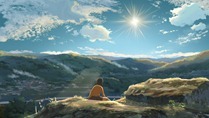
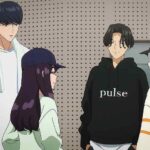
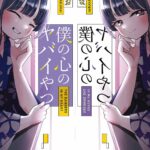
marinasauce
December 8, 2011 at 9:29 amI have seen all the previous works of Shinkai, all but this one. It's definitely on my list and has been the day I saw it on my the anime chart some time ago. I absolutely love your review about it which expresses a love for not only the director and his art, but for anime in its entirety. I really look forward to my first viewing of the movie 🙂 Thanks, Enzo!
admin
December 8, 2011 at 9:58 amThanks, marinarasauce – very kind of you to say so. Shinkai is a very special talent and he really moves me to write like few others can.
Anonymous
December 8, 2011 at 9:18 pmscenery porn at its best
totoum
December 9, 2011 at 12:03 amMan,great review,I share the same feelings as you but just couldn't put them into words.Especialy like how you call Shinkai a visual poet and call this his most prosaic work,that's a really nice way to put it.
I also agree with him trying to do too much (but hey,I preffer that over doing too little!) I especialy wanted more on the Shin/Shun relationship.It really seemed like Shin was trying to step out of his brother's shaddow.
I just reread the interview he gave to ANN earlier in the year and I find it interesting how he considers this his directorial debut because before he didn't really have a team to "direct".
What I also found interesting is how he describes the setting as 2 worlds but doesn't refer to the first we see as "rural japan" but rather "a world that looks like rural japan".
He also had no idea about what he would do next but was definatly very open about getting feedback from the movie.
I'd also want to praise Miyu Irino (but really,I've come to expect greatness from this guy) as well as Kanemoto Hisako,not so much for making me forget about Ika musume but because I really think she's come a long ways in a short time since I first heard her in Sora no Woto.
The one point where our views differ is that my favorite part of 5cm/second is the 2nd one,it's by far the one I've rewatched the most (but I know I'm very much in the minority).
admin
December 9, 2011 at 12:19 amThanks, totoum. Shinkai inspires me to florid prose, as that's the best I can do – bar the occasional ecchi haiku I just don't have poetry in the blood.
I do think this entire main cast is superb. As you probably know Miyu-miyu is my favorite seiyuu of his generation, and I have Kanemoto-san "Best Actress" last year for Ika Musume. But Inoue just floored me with his performance as Morisaki – he brings so much complexity to that role, which to be fair is the most interesting in the movie. As I said, though, it felt a bit weird to hear familiar voices in a Shinkai film.
Anonymous
December 9, 2011 at 7:39 amThe seiyuu I noticed most (indeed, the only one) was Itou Kanae. Kinda odd, and somewhat jarring, to hear such a familiar voice.
By comparison, I didn't recognize Kanemoto Hisako's voice at all, even though I remember seeing her name in the beginning of your post before watching the show.
admin
December 9, 2011 at 7:45 amYeah, I noticed Itou-san right away too, though that's a fairly minor part.
Seishun Otoko
December 10, 2011 at 8:34 amWow… a very good movie indeed and excellent review as always (1892 words!!! How long did you take to write this?). Can't agree more with what you said, the writing did leave quite a bit to be desired but the visuals more than made up for it. The ending felt especially rushed and might have worked better if Shinkai sensei had an extra 15 minutes to wrap things up. If I didn't know better, I would have easily mistaken Hoshi as another Ghibli's effort and a pretty good one at that. Kanemoto Hisako did a brilliant job as Asuna and she hasn't even been in the industry for that long. Definitely expecting great things from her in the future 🙂
admin
December 10, 2011 at 5:03 pmWow, you're counting words on me???
Seishun Otoko
December 10, 2011 at 10:41 pmI want curious so I copy pasted your review into Words… 😛
admin
December 10, 2011 at 11:07 pmDon't tase me, Bro!
I knew it was long – but when it comes to Shinkai, I have a lot to say. And as I lack the talent for poetry, all I can do is substitute quantity of words for quality…
Seishun Otoko
December 11, 2011 at 12:04 amDidn't mean to tease and I wish I could write like you 🙂
admin
December 11, 2011 at 7:41 amAll good Seishun, just teasing you back!
Anonymous
January 5, 2012 at 12:27 am>>>>I honestly don’t think it’s an exaggeration to say that Shinkai Makoto is the most important anime director in the world.
There is probably a sizeable crowd of the current generation of online anime fans who would agree with you.
I am not among them, and I must admit that my skepticism grows when he recieves such high praise. Shinkai is an excellent painter of certain moods (which he has consistently recycled in his previous major works) not a storyteller, and a problem arises from the fact that I am not particularly moved by his artwork (which I find too glossy and sterile to be beautiful in any human sense), which is clearly a problem considering your defense of him seems to rely heavily on his visual poetry. OF course, I tend to believe believe true, universal beauty lies within characters and within narrative, which are not Shinkai's strengths, while such beauty is effortlessly abundant in the best films of Miyazaki (Totoro), Satoshi Kon (Millenium Actress), Isao Takahata (Grave of the Fireflies).
When I am in a skeptical mood, I tend to think that Shinkai is a director who will be forgotten in the larger scheme of things, and that his work has only temporary appeal to a particular, predominantly young, subculture due to his production values and reliance on melancholic monologues. I appreciate Shinkai's attempt to step outside his comfort zone with his latest film, but I found the result (Hoshi wo Ou Kodomo) to merely be a collection of ideas from various influences cobbled together unconvincingly.
I feel somewhat apologetic about my tone (I've rewritten this comment a few times to minimize this), but I must be truthful and admit that I consider the elevation of Makoto Shinkai to 'greatest anime director' to be a very shallow premise, in a similar vein as rating the latest fads in literature, such as Harry Potter, as great literature. With that being said – you are clearly earnest in your feelings and your writing in this article shows it, so I am more than willing to respect your opinion and agree to disagree. But I figure a skeptical comment would be useful in the face of such a glowing estimation.